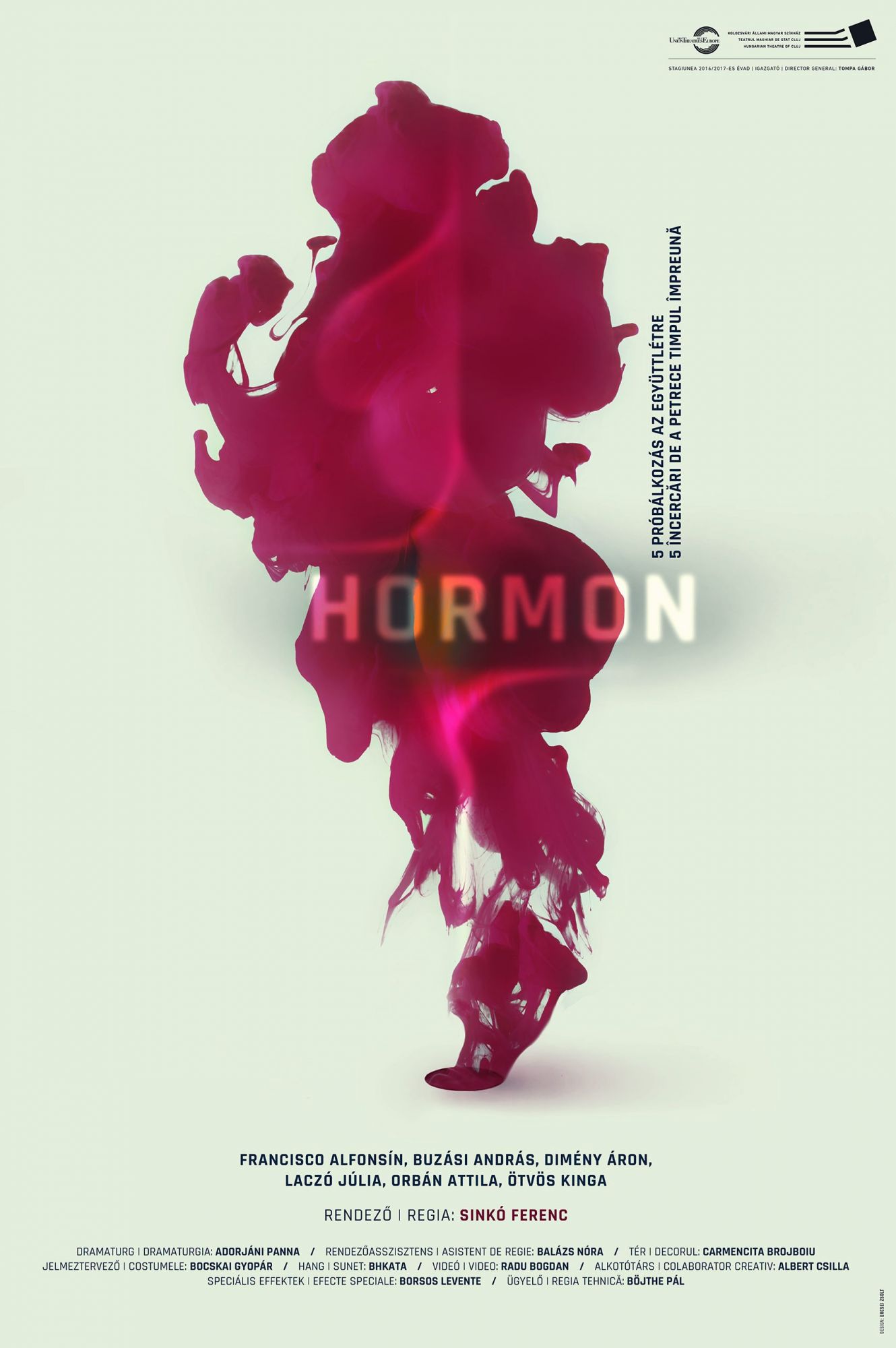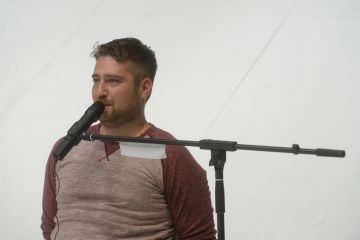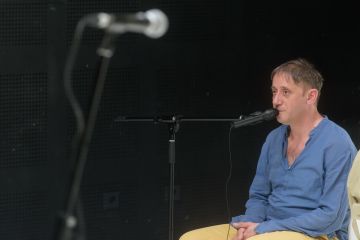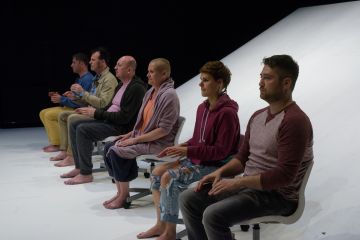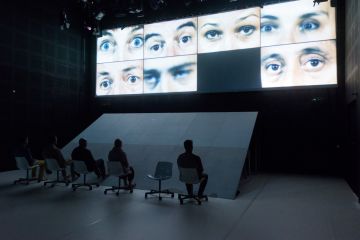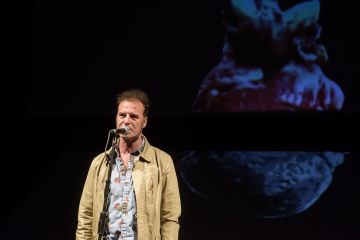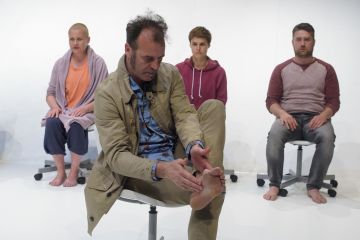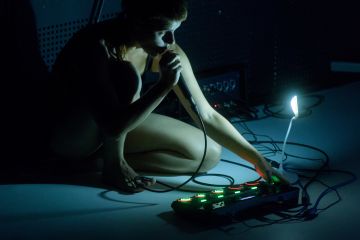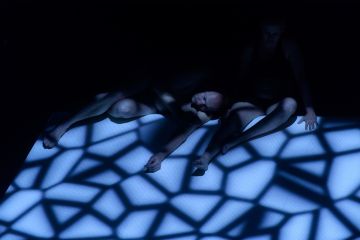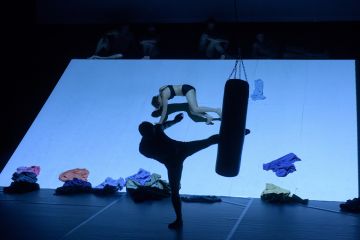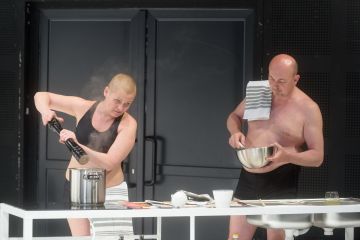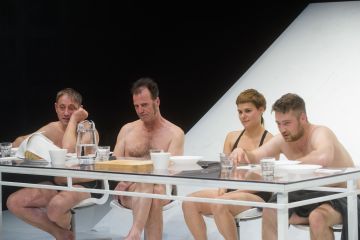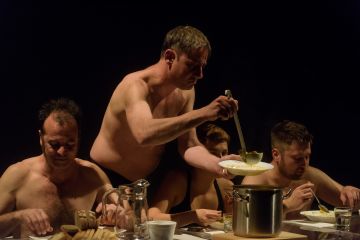These exercises focus primarily on the body existing within the intense space of playing and are directed on the concentrated efforts of paying attention to each other at the time of the intensive play. The characteristic elements and focal points of Sinkó’s world of directing: bodies in space, which somehow relate to each other while paying a high degree of attention to each other. (Or sometimes do not relate to one another, also with a heightened degree of attention.) At times, there are individual moments within the events that are unfolding, when a player attempts to relate to those of us, who are sitting opposed to him/her. With the removal of the garments (which in this context are unequivocally costumes) the bodies themselves become more accentuated. (...) The missing keyword from Hormone’s system is the fact that it makes us reexamine our experience from the standpoint of what is missing after the events that have taken place within the space and time of the performance. We are not even sure that we have taken part in the event in the first place. And if we examine it from the standpoint of that which was missing, after the act itself, then we will no longer reproach our lost time, but we look at it as a time for a ritual that we missed, as a mythical time which we had the opportunity to join, but did not take advantage of the opportunity given. The truth is that the use of plural is unjustified. This is how I experienced and interpreted it.
Botond Fischer: A hiány rítusai [The Rites of Ellipsis], Színház.net, July 13, 2017
Most of the movements used in the performance are primary, ritual movements almost, but free of any solemnity or pathos. Events. With all the secondary and multidimensional content stemming from the viewer. (...) The performance addresses the viewers and their world of fantasy with experimentation and earnest trust. The lack of specific content, stories and conflicts have a rather refreshing effect in this case, still, it can easily remain on the level of artsy and superficial. The sense of rhythm of the creators and performers, as well as the simple and liberating presence of each of them draws and maintains our attention almost constantly.
Kata Győrfi: A tekintetek mégis találkoznak [Our Glances Still Do Meet], Helikon, June 10, 2017
In a performance piece in which words are scarce and the audio-visual realm does not contribute to the coherence of a semiotic understanding, Hormone... understands both the production and the reception of a performative act as simple and sufficient forms of time spent; there is no (more) hierarchy between the time of life and that of art. The conflict, as well as the climactic points of tension seem to have already occurred, perhaps even before entering the “performance” venue; the artistic intention thus lightly provoking an implosion.
The Hungarian Theatre of Cluj’s proposal remains a challenge in the face of the need to be permanently satisfied by a (mental) stimulus delivering meanings to be decrypted, as a result of which maybe to congratulate ourselves for understanding more than we have shown. However, this time, gratification will not be instant.
Ana Tecar: Pulverizările unui climax deja întâmplat [The Splash of an Already Occurred Climax - Hormone - 5 attempts to spend time together], Liternet.ro, June 29, 2017
Of course, we are once again talking about an experimental, niche theater, which, however, addresses an acutely topical subject - as did #swansong. One that has remained as such from the “absurds” on. That of inter-human communication. It remains so from "absurd" to this. That of inter-human communication. The way in which we spend the time that has been given us to look, to get to know, and to understand one another. No matter the language we speak, our occupations, or aspirations. Maybe that's why the first sequence of the five of which the performance is composed is played in three languages - English, Romanian, Hungarian. Do we communicate, receive, perceive, stand, accept, and understand each other?
Mircea Morariu: Consecvent experimentului. Premiere la Teatrul Maghiar de Stat din Cluj-Napoca [Dedicated to the Experiment. Premieres at the Hungarian Theatre of Cluj-Napoca], Adevărul, June 8, 2017
Isn’t it wonderful to listen to music with someone? Or to watch TV? The natural, normal things do not require medical expertise. (...) Together we are in the pursuit of and within the challenge that are the hormones of joy. We shy away together from the passing of time, from the virtual aggressions coming from outside of ourselves, with one of the "challenges" taking place with a boxing bag moving as a pendulum between the artists, yet also when the hormones appear in response to fear or stress. “What is man if not a knot of relationships?” asked rhetorically Antoine de Saint-Exupéry, emphasizing the importance of these relationships.
Adrian Ţion: „Împreună” la Teatrul Maghiar” ["Together" at the Hungarian Theatre], Ziar de Cluj, January 9, 2018









